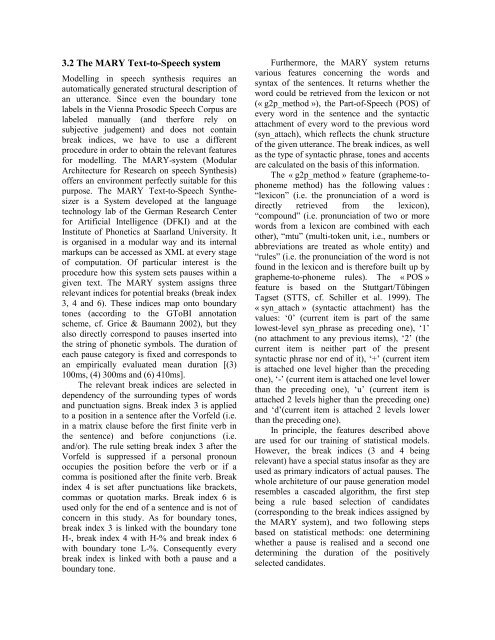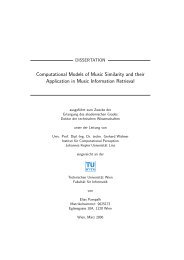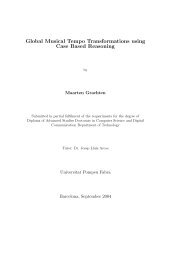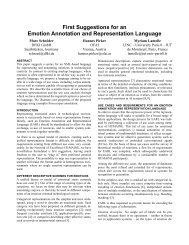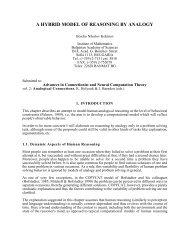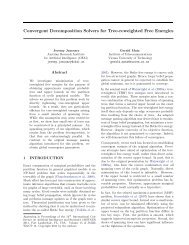Have a break! Modelling pauses in German Speech. - ResearchGate
Have a break! Modelling pauses in German Speech. - ResearchGate
Have a break! Modelling pauses in German Speech. - ResearchGate
Create successful ePaper yourself
Turn your PDF publications into a flip-book with our unique Google optimized e-Paper software.
3.2 The MARY Text-to-<strong>Speech</strong> system<br />
<strong>Modell<strong>in</strong>g</strong> <strong>in</strong> speech synthesis requires an<br />
automatically generated structural description of<br />
an utterance. S<strong>in</strong>ce even the boundary tone<br />
labels <strong>in</strong> the Vienna Prosodic <strong>Speech</strong> Corpus are<br />
labeled manually (and therfore rely on<br />
subjective judgement) and does not conta<strong>in</strong><br />
<strong>break</strong> <strong>in</strong>dices, we have to use a different<br />
procedure <strong>in</strong> order to obta<strong>in</strong> the relevant features<br />
for modell<strong>in</strong>g. The MARY-system (Modular<br />
Architecture for Research on speech Synthesis)<br />
offers an environment perfectly suitable for this<br />
purpose. The MARY Text-to-<strong>Speech</strong> Synthesizer<br />
is a System developed at the language<br />
technology lab of the <strong>German</strong> Research Center<br />
for Artificial Intelligence (DFKI) and at the<br />
Institute of Phonetics at Saarland University. It<br />
is organised <strong>in</strong> a modular way and its <strong>in</strong>ternal<br />
markups can be accessed as XML at every stage<br />
of computation. Of particular <strong>in</strong>terest is the<br />
procedure how this system sets <strong>pauses</strong> with<strong>in</strong> a<br />
given text. The MARY system assigns three<br />
relevant <strong>in</strong>dices for potential <strong>break</strong>s (<strong>break</strong> <strong>in</strong>dex<br />
3, 4 and 6). These <strong>in</strong>dices map onto boundary<br />
tones (accord<strong>in</strong>g to the GToBI annotation<br />
scheme, cf. Grice & Baumann 2002), but they<br />
also directly correspond to <strong>pauses</strong> <strong>in</strong>serted <strong>in</strong>to<br />
the str<strong>in</strong>g of phonetic symbols. The duration of<br />
each pause category is fixed and corresponds to<br />
an empirically evaluated mean duration [(3)<br />
100ms, (4) 300ms and (6) 410ms].<br />
The relevant <strong>break</strong> <strong>in</strong>dices are selected <strong>in</strong><br />
dependency of the surround<strong>in</strong>g types of words<br />
and punctuation signs. Break <strong>in</strong>dex 3 is applied<br />
to a position <strong>in</strong> a sentence after the Vorfeld (i.e.<br />
<strong>in</strong> a matrix clause before the first f<strong>in</strong>ite verb <strong>in</strong><br />
the sentence) and before conjunctions (i.e.<br />
and/or). The rule sett<strong>in</strong>g <strong>break</strong> <strong>in</strong>dex 3 after the<br />
Vorfeld is suppressed if a personal pronoun<br />
occupies the position before the verb or if a<br />
comma is positioned after the f<strong>in</strong>ite verb. Break<br />
<strong>in</strong>dex 4 is set after punctuations like brackets,<br />
commas or quotation marks. Break <strong>in</strong>dex 6 is<br />
used only for the end of a sentence and is not of<br />
concern <strong>in</strong> this study. As for boundary tones,<br />
<strong>break</strong> <strong>in</strong>dex 3 is l<strong>in</strong>ked with the boundary tone<br />
H-, <strong>break</strong> <strong>in</strong>dex 4 with H-% and <strong>break</strong> <strong>in</strong>dex 6<br />
with boundary tone L-%. Consequently every<br />
<strong>break</strong> <strong>in</strong>dex is l<strong>in</strong>ked with both a pause and a<br />
boundary tone.<br />
Furthermore, the MARY system returns<br />
various features concern<strong>in</strong>g the words and<br />
syntax of the sentences. It returns whether the<br />
word could be retrieved from the lexicon or not<br />
(« g2p_method »), the Part-of-<strong>Speech</strong> (POS) of<br />
every word <strong>in</strong> the sentence and the syntactic<br />
attachment of every word to the previous word<br />
(syn_attach), which reflects the chunk structure<br />
of the given utterance. The <strong>break</strong> <strong>in</strong>dices, as well<br />
as the type of syntactic phrase, tones and accents<br />
are calculated on the basis of this <strong>in</strong>formation.<br />
The « g2p_method » feature (grapheme-tophoneme<br />
method) has the follow<strong>in</strong>g values :<br />
“lexicon” (i.e. the pronunciation of a word is<br />
directly retrieved from the lexicon),<br />
“compound” (i.e. pronunciation of two or more<br />
words from a lexicon are comb<strong>in</strong>ed with each<br />
other), “mtu” (multi-token unit, i.e., numbers or<br />
abbreviations are treated as whole entity) and<br />
“rules” (i.e. the pronunciation of the word is not<br />
found <strong>in</strong> the lexicon and is therefore built up by<br />
grapheme-to-phoneme rules). The « POS »<br />
feature is based on the Stuttgart/Tüb<strong>in</strong>gen<br />
Tagset (STTS, cf. Schiller et al. 1999). The<br />
« syn_attach » (syntactic attachment) has the<br />
values: ‘0’ (current item is part of the same<br />
lowest-level syn_phrase as preced<strong>in</strong>g one), ‘1’<br />
(no attachment to any previous items), ‘2’ (the<br />
current item is neither part of the present<br />
syntactic phrase nor end of it), ‘+’ (current item<br />
is attached one level higher than the preced<strong>in</strong>g<br />
one), ‘-’ (current item is attached one level lower<br />
than the preced<strong>in</strong>g one), ‘u’ (current item is<br />
attached 2 levels higher than the preced<strong>in</strong>g one)<br />
and ‘d’(current item is attached 2 levels lower<br />
than the preced<strong>in</strong>g one).<br />
In pr<strong>in</strong>ciple, the features described above<br />
are used for our tra<strong>in</strong><strong>in</strong>g of statistical models.<br />
However, the <strong>break</strong> <strong>in</strong>dices (3 and 4 be<strong>in</strong>g<br />
relevant) have a special status <strong>in</strong>sofar as they are<br />
used as primary <strong>in</strong>dicators of actual <strong>pauses</strong>. The<br />
whole architeture of our pause generation model<br />
resembles a cascaded algorithm, the first step<br />
be<strong>in</strong>g a rule based selection of candidates<br />
(correspond<strong>in</strong>g to the <strong>break</strong> <strong>in</strong>dices assigned by<br />
the MARY system), and two follow<strong>in</strong>g steps<br />
based on statistical methods: one determ<strong>in</strong><strong>in</strong>g<br />
whether a pause is realised and a second one<br />
determ<strong>in</strong><strong>in</strong>g the duration of the positively<br />
selected candidates.


